Related Research Articles

Louis VII, called the Younger or the Young to differentiate him from his father Louis VI, was King of France from 1137 to 1180. His first marriage was to Duchess Eleanor of Aquitaine, one of the wealthiest and most powerful women in western Europe. The marriage temporarily extended the Capetian lands to the Pyrenees.

The Basilica of Saint-Denis is a large former medieval abbey church and present cathedral in the commune of Saint-Denis, a northern suburb of Paris. The building is of singular importance historically and architecturally as its choir, completed in 1144, is widely considered the first structure to employ all of the elements of Gothic architecture.
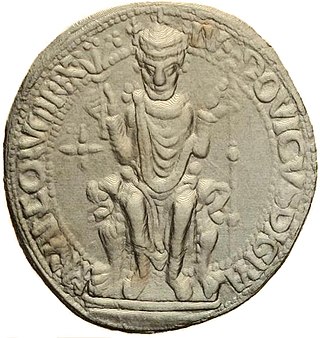
Louis VI, called the Fat or the Fighter, was King of the Franks from 1108 to 1137. Like his father Philip I, Louis made a lasting contribution to centralizing the institutions of royal power. He spent much of his twenty-nine-year reign fighting either the "robber barons" who plagued the Ile de France or Henry I of England for his continental possession of Normandy. Nonetheless, Louis VI managed to reinforce his power considerably, often resorting to force to bring lawless knights to justice, and was the first member of the house of Capet to issue ordonnances applying to the whole of the kingdom of France.
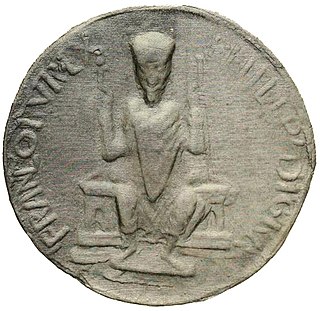
Philip I, called the Amorous, was King of the Franks from 1060 to 1108. His reign, like that of most of the early Capetians, was extraordinarily long for the time. The monarchy began a modest recovery from the low it had reached during the reign of his father, Henry I, and he added the Vexin region and the viscountcy of Bourges to his royal domaine.
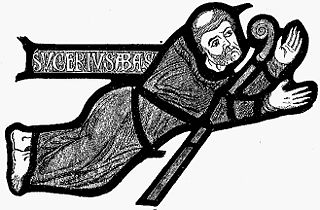
Suger was a French abbot and statesman. He was a key advisor to King Louis VI and his son Louis VII, acting as the latter's regent during the Second Crusade. His writings remain seminal texts for early twelfth-century Capetian history, and his reconstruction of the Basilica of Saint-Denis where he was abbot was instrumental in the creation of Gothic architecture.

Denis of France was a 3rd-century Christian martyr and saint. According to his hagiographies, he was bishop of Paris in the third century and, together with his companions Rusticus and Eleutherius, was martyred for his faith by decapitation. Some accounts placed this during Domitian's persecution and incorrectly identified St Denis of Paris with the Areopagite who was converted by Paul the Apostle and who served as the first bishop of Athens. Assuming Denis's historicity, it is now considered more likely that he suffered under the persecution of the emperor Decius shortly after AD 250.
Victor IV was elected as a Ghibelline antipope in 1159, following the death of Pope Adrian IV and the election of Alexander III. His election was supported by Emperor Frederick Barbarossa. He took the name Victor IV, not acknowledging Antipope Victor IV of 1138, whose holding of the papal office was deemed illegitimate.

The Archdiocese of Reims or Rheims is a Latin Church ecclesiastic territory or archdiocese of the Catholic Church in France. Erected as a diocese around 250 by Sixtus of Reims, the diocese was elevated to an archdiocese around 750. The archbishop received the title "primate of Gallia Belgica" in 1089.

The Diocese of Beauvais, Noyon, and Senlis is a Latin Church ecclesiastical territory or diocese of the Catholic Church in France. The diocese encompasses the department of Oise in the region of Hauts-de-France. The diocese is a suffragan of the metropolitan Archdiocese of Reims. The current bishop is Jacques Benoit-Gonnin, appointed in 2010.

Maurice de Sully was Bishop of Paris from 1160 until his retirement in 1196. He was responsible for the construction of the Cathedral of Notre-Dame.

The Diocese of Tulle is a Latin Church diocese of the Catholic Church in Tulle, France. The diocese of Tulle comprises the whole département of Corrèze.

Saint Fulrad was a French religious leader who was the Abbot of Saint-Denis. He was the counselor of both Pepin the Short and Charlemagne. Historians see Fulrad as important due to his significance in the rise of the Frankish Kingdom, and the insight he gives into early Carolingian society. He was noted to have been always on the side of Charlemagne, especially during the attack from the Saxons on Regnum Francorum, and the Royal Mandatum. Other historians have taken a closer look at Fulrad's interactions with the papacy. When Fulrad was the counselor of Pepin he was closely in contact with the papacy to gain approval for Pepin's appointment as King of the Franks. During his time under Charlemagne, he had dealings with the papacy again for different reasons. When he became Abbot of Saint-Denis in the mid-eighth century, Fulrad became important in the lives of distinct historical figures in various ways. Saint Fulrad's Feast Day is on 16 July.

The Diocese of Amiens is a Latin Church diocese of the Catholic Church in France. The diocese comprises the department of Somme, of which the city of Amiens is the capital. In 2022 it was estimated that there was one priest for every 6,916 Catholics in the diocese.
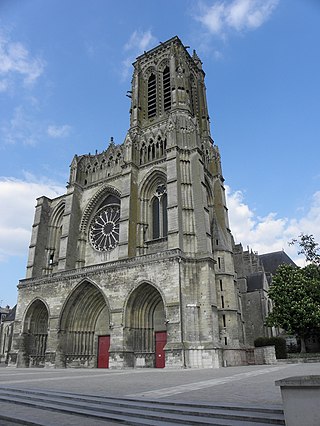
The Diocese of Soissons, Laon, and Saint-Quentin is a Latin Church diocese of the Catholic Church in France. The diocese is suffragan to the Archdiocese of Reims and corresponds, with the exception of two hamlets, to the entire Department of Aisne. The current bishop is Renauld Marie François Dupont de Dinechin, appointed on 30 October 2015. In 2022, in the Diocese of Soissons there is one priest for every 5,594 Catholics.

The Diocese of Le Puy-en-Velay is a Latin diocese of the Catholic Church in France. The diocese comprises the whole Department of Haute-Loire, in the Region of Auvergne-Rhône-Alpes.
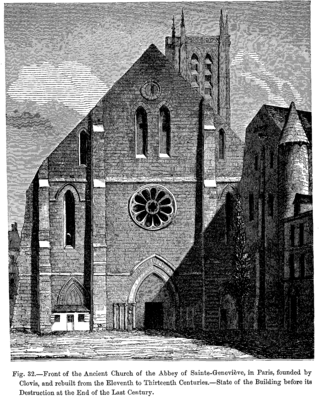
The Abbey of Saint Genevieve was a monastery in Paris. Reportedly built by Clovis, King of the Franks in 502, it became a centre of religious scholarship in the Middle Ages. It was suppressed at the time of the French Revolution.

In the 10th century Paris was a provincial cathedral city of little political or economic significance, but under the kings of the Capetian dynasty who ruled France between 987 and 1328, it developed into an important commercial and religious center and the seat of the royal administration of the country. The Île de la Cité became the site of the royal palace and the new cathedral of Notre-Dame, begun in 1163. The Left Bank was occupied by important monasteries, including the Abbey of Saint-Germain-des-Prés and the Abbey of St Genevieve. In the late 1100s, the collection of colleges on the left bank became one of the leading universities in Europe. The Right Bank, where the ports, central markets, artisans and merchants were located, became the commercial center of the city, and the merchants assumed an important role in running the city. Paris became a center for the creation of illuminated manuscripts and the birthplace of Gothic architecture. Despite civil wars, the plague, and foreign occupation, Paris became the most populous city in the Western world during the Middle Ages.

Philip II, called Philippe de Méréville or Philippe de Nemours, was the bishop of Châlons from 1228 until his death. He was a member of the nobility of the Île-de-France, and was a priest in Paris before coming to Châlons. As bishop, he was a consistent ally of Count Theobald IV of Champagne, in whose county his diocese lay.

Charles Poerson was a French painter. He is also notable as the father and tutor of the painter Charles-François Poerson.

Gothic cathedrals and churches are religious buildings created in Europe between the mid-12th century and the beginning of the 16th century. The cathedrals are notable particularly for their great height and their extensive use of stained glass to fill the interiors with light. They were the tallest and largest buildings of their time and the most prominent examples of Gothic architecture. The appearance of the Gothic cathedral was not only a revolution in architecture; it also introduced new forms in decoration, sculpture, and art.
References
- ↑ Suger (Abbot of Saint Denis) 1992, p. 149.
- ↑ Lewis 1995, p. 111.
- ↑ Lewis 1995, p. 114.
- ↑ Lewis 1995, p. 114-115.
- ↑ Lewis 1995, p. 116.
- ↑ Lewis 1995, p. 115.
- ↑ Lewis 1995, p. 115-116.
- 1 2 3 Lewis 1995, p. 120.
- 1 2 3 4 Lewis 1995, p. 117.
- 1 2 Lewis 1995, p. 118.
- 1 2 3 Lewis 1995, p. 119.
- 1 2 Lewis 1995, p. 112-113.